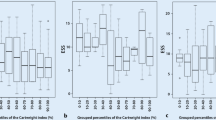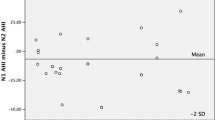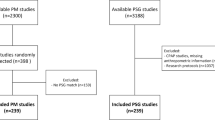Abstract
Background
The severity of position-dependent obstructive sleep apnea (POSA) depends on the nonsupine and supine apnea–hypopnea index (AHI) as well as the time spent in supine position. The latter in particular is susceptible to variation. Several small-scale studies suggest that wearing polysomnography (PSG) apparatus leads to an increase in supine sleeping position.
Objectives
The aim of this study was to evaluate the effect of wearing PSG apparatus on sleeping position and on OSA severity.
Material and methods
A large-scale, retrospective study was performed, including a consecutive series of POSA and non-apneic snoring patients who were prescribed positional therapy (Sleep Position Trainer [SPT]). The effect of wearing PSG apparatus on sleeping position was evaluated by comparing body position during the PSG night and inactive (diagnostic) phase of SPT.
Results
The mean percentage of total recording time (TRT) in supine position was 43.1% during the PSG night phase compared with 28.6% of TRT during the inactive (diagnostic) phase of SPT; i.e., a significant decrease of 33.6% (p < 0.001). When adjusting the AHI using TRT in different sleeping positions measured with the SPT, the median AHI decreased from 13.3/h (9.0–20.4) to 10.3/h (6.8–16.2); p < 0.001. When using the adjusted AHI, 33% (N = 66) of all patients had a change in OSA severity.
Conclusions
The results of this study indicate that wearing PSG apparatus leads to an increase in the percentage of supine sleeping position causing an overestimation of OSA severity, especially in patients with POSA. This can have significant impact on both clinical and scientific practice.
Zusammenfassung
Hintergrund
Der Schweregrad der positionsabhängigen obstruktiven Schlafapnoe (POSA) hängt vom Apnoe-Hypopnoe-Index (AHI) in anderer Haltung als Rückenlage und in Rückenlage sowie der Verweildauer in Rückenlage ab. Insbesondere Letztere ist anfällig für Schwankungen. Mehrere kleinere Studien deuten darauf hin, dass das Tragen von Polysomnographiegeräten (PSG) zu einer erhöhten Dauer der Schlafposition in Rückenlage führt.
Ziele
Ziel dieser Studie war es, die Auswirkungen des Tragens von PSG-Geräten auf die Schlafposition und dessen Einfluss auf den OSA-Schweregrad zu beurteilen.
Material und Methoden
Es erfolgte eine groß angelegte retrospektive Studie mit einer konsekutiven Serie von POSA- und nichtapnoischen Schnarchpatienten, die eine vordefinierte Positionstherapie (Sleep Position Trainer, SPT) erhielten. Der Einfluss des Tragens von PSG-Geräten auf die Schlafposition wurde durch den Vergleich der Körperposition während der PSG-Nacht und der inaktiven (diagnostischen) Phase der SPT bewertet.
Ergebnisse
Der mittlere Prozentsatz der Gesamtaufnahmezeit („total recording time“, TRT) in Rückenlage betrug 43,1 % während der PSG-Nacht gegenüber 28,6 % der TRT während der inaktiven (diagnostischen) Phase der SPT; ein signifikanter Rückgang von 33,6 % (p < 0,001). Bei Einstellung des AHI mit TRT in verschiedenen Schlafpositionen mit SPT sank der mittlere AHI von 13,3/h (9,0–20,4) auf 10,3/h (6,8–16,2); p < 0,001. Bei Verwendung des angepassten AHI war bei 33 % (n = 66) aller Patienten der OSA-Schweregrad verändert.
Schlussfolgerungen
Den Ergebnissen dieser Studie zufolge kommt es durch das Tragen von PSG-Geräten zum Anstieg des Prozentsatzes der Schlafposition in Rückenlage und somit zur Überschätzung des OSA-Schweregrads, v. a. bei Patienten mit POSA. Dies kann in der klinischen und in der wissenschaftlichen Praxis erhebliche Auswirkungen haben.



Similar content being viewed by others
References
Ravesloot M, Van Maanen J, Dun L, De Vries N (2013) The undervalued potential of positional therapy in position-dependent snoring and obstructive sleep apnea—a review of the literature. Sleep Breath 17(1):39–49
Ravesloot MJ, Frank MH, van Maanen JP, Verhagen EA, de Lange J, de Vries N (2016) Positional OSA part 2: retrospective cohort analysis with a new classification system (APOC). Sleep Breath 20(2):881–888. https://doi.org/10.1007/s11325-015-1206-y
Cartwright RD (1984) Effect of sleep position on sleep apnea severity. Sleep 7(2):110–114
Oksenberg A (2005) Positional and non-positional obstructive sleep apnea patients. Sleep Med 6(4):377–378. https://doi.org/10.1016/j.sleep.2005.03.012
Richard W, Kox D, den Herder C, Laman M, van Tinteren H, de Vries N (2006) The role of sleep position in obstructive sleep apnea syndrome. Eur Arch Otorhinolaryngol 263(10):946–950. https://doi.org/10.1007/s00405-006-0090-2
Heinzer R, Petitpierre NJ, Marti-Soler H, Haba-Rubio J (2018) Prevalence and characteristics of positional sleep apnea in the HypnoLaus population-based cohort. Sleep Med 48:157–162. https://doi.org/10.1016/j.sleep.2018.02.011
Dieltjens M, Vroegop AV, Verbruggen AE, Wouters K, Willemen M, De Backer WA, Verbraecken JA, Van de Heyning PH, Braem MJ, de Vries N, Vanderveken OM (2015) A promising concept of combination therapy for positional obstructive sleep apnea. Sleep Breath 19(2):637–644. https://doi.org/10.1007/s11325-014-1068-8
Benoist LB, Verhagen M, Torensma B, van Maanen JP, de Vries N (2016) Positional therapy in patients with residual positional obstructive sleep apnea after upper airway surgery. Sleep Breath. https://doi.org/10.1007/s11325-016-1397-x
Frank MH, Ravesloot MJ, van Maanen JP, Verhagen E, de Lange J, de Vries N (2015) Positional OSA part 1: towards a clinical classification system for position-dependent obstructive sleep apnoea. Sleep Breath 19(2):473–480. https://doi.org/10.1007/s11325-014-1022-9
Oksenberg A, Gadoth N (2014) Are we missing a simple treatment for most adult sleep apnea patients? The avoidance of the supine sleep position. J Sleep Res 23(2):204–210. https://doi.org/10.1111/jsr.12097
Ravesloot MJL, White D, Heinzer R, Oksenberg A, Pepin JL (2017) Efficacy of the new generation of devices for positional therapy for patients with positional obstructive sleep apnea: a systematic review of the literature and Meta-analysis. J Clin Sleep Med 13(6):813–824. https://doi.org/10.5664/jcsm.6622
van Maanen JP, de Vries N (2014) Long-term effectiveness and compliance of positional therapy with the sleep position trainer in the treatment of positional obstructive sleep apnea syndrome. Sleep 37(7):1209–1215. https://doi.org/10.5665/sleep.3840
van Maanen JP, Meester KA, Dun LN, Koutsourelakis I, Witte BI, Laman DM, Hilgevoord AA, de Vries N (2013) The sleep position trainer: a new treatment for positional obstructive sleep apnoea. Sleep Breath 17(2):771–779. https://doi.org/10.1007/s11325-012-0764-5
Vonk P, Ravesloot M (2018) Positional obstructive sleep apnea. Somnologie 22(2):79–84
Logan MB, Branham GH, Eisenbeis JF, Hartse K (1996) 11: 48 AM: unattended home monitoring in the evaluation of sleep apnea: is it equal to formal Polysomnograph? Otolaryngol Head Neck Surg 115(2):156–156
Metersky ML, Castriotta RJ (1996) The effect of polysomnography on sleep position: possible implications on the diagnosis of positional obstructive sleep apnea. Respiration 63(5):283–287
Bignold JJ, Mercer JD, Antic NA, McEvoy RD, Catcheside PG (2011) Accurate position monitoring and improved supine-dependent obstructive sleep apnea with a new position recording and supine avoidance device. J Clin Sleep Med 7(4):376–383. https://doi.org/10.5664/JCSM.1194
Eijsvogel MM, Ubbink R, Dekker J, Oppersma E, de Jongh FH, van der Palen J, Brusse-Keizer MG (2015) Sleep position trainer versus tennis ball technique in positional obstructive sleep apnea syndrome. J Clin Sleep Med 11(2):139–147. https://doi.org/10.5664/jcsm.4460
Berry RB, Budhiraja R, Gottlieb DJ, Gozal D, Iber C, Kapur VK, Marcus CL, Mehra R, Parthasarathy S, Quan SF (2012) Rules for scoring respiratory events in sleep: update of the 2007 AASM manual for the scoring of sleep and associated events: deliberations of the sleep apnea definitions task force of the American Academy of Sleep Medicine. J Clin Sleep Med 8(5):597
Wimaleswaran H, Yo S, Buzacott H, Lim M‑T, Wong A‑M, Edwards B et al (2018) Sleeping position during laboratory polysomnography compared to habitual sleeping position at home. J Sleep Res 27
van Kesteren ER, van Maanen JP, Hilgevoord AA, Laman DM, de Vries N (2011) Quantitative effects of trunk and head position on the apnea hypopnea index in obstructive sleep apnea. Sleep 34(8):1075–1081. https://doi.org/10.5665/SLEEP.1164
Bidarian-Moniri A, Nilsson M, Rasmusson L, Attia J, Ejnell H (2015) The effect of the prone sleeping position on obstructive sleep apnoea. Acta Otolaryngol 135(1):79–84
Kaur A, Verma R, Gandhi A, Riaz S, Vega-Sanchez M, Jaffe F, Yu D, Chatila W, D’alonzo G, Weaver S (2017) Effect of disease severity on determining body position during sleep in patients with positional obstructive sleep apnea. J Sleep Sleep Disord Res 40(suppl_1):A233–A233
Joosten SA, O’Driscoll DM, Berger PJ, Hamilton GS (2014) Supine position related obstructive sleep apnea in adults: pathogenesis and treatment. Sleep Med Rev 18(1):7–17
Cartwright R, Ristanovic R, Diaz F, Caldarelli D, Alder G (1991) A comparative study of treatments for positional sleep apnea. Sleep 14(6):546–552
Kavey NB, Blitzer A, Gidro-Frank S, Korstanje K (1985) Sleeping position and sleep apnea syndrome. Am J Otolaryngol 6(5):373–377
Author information
Authors and Affiliations
Corresponding author
Ethics declarations
Conflict of interest
N. de Vries is a member of the Medical Advisory Board of NightBalance and has shares in NightBalance. He is also an investigator for Inspire and Jazz Pharmaceutics, a consultant for Philips, Olympus, and the AE Mann Foundation and has an inventor patent on PCT/US2010/062576 including devices, systems, and methods for monitoring sleep position. P.E. Vonk and M.J.L. Ravesloot declare that they have no conflicts of interest or financial ties to disclose.
All procedures performed in studies involving human participants or on human tissue were in accordance with the ethical standards of the institutional and/or national research committee and with the 1975 Helsinki declaration and its later amendments or comparable ethical standards. Informed consent was not required for this type of study.
Rights and permissions
About this article
Cite this article
Vonk, P.E., de Vries, N. & Ravesloot, M.J.L. Polysomnography and sleep position, a Heisenberg phenomenon?. HNO 67, 679–684 (2019). https://doi.org/10.1007/s00106-019-0678-7
Published:
Issue Date:
DOI: https://doi.org/10.1007/s00106-019-0678-7




